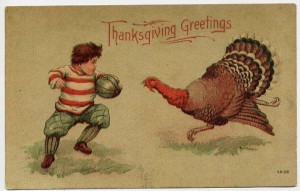Choosing Your Thanksgiving Turkey
What I really know about turkeys amounts to this: they need a lot of basting. I’ve cooked four turkeys in my entire cooking career, but I’ve basted at least 30 of them. I grew up eating the kind that had yellow lumps under the skin and the little thermometer that would pop out to let you know the turkey was done. No offense to my Grandma, who established our family turkey tradition when Butterball was the premium, top-of-the-line Thanksgiving turkey, but I like to think I’m a little more discerning in my tastes now. Not to mention there are so many more turkey options. How do you choose the right one? If you would like to find the perfect turkey for your budget and taste, and are curious as to what all the terms on the labels mean, read on.
Turkeys are labeled according to how they were raised, processed and prepared for market. The definitions of the terms come from the USDA.
Fresh Turkey
According to the National Turkey Federation, turkey freezes closer to 26° F rather than 32° F. If it has not been chilled below 26° F it can be labeled as a fresh turkey. The turkey can be held up to 2 months before it is sent to market and still be called fresh. Turkeys labeled as fresh cost slightly more than a frozen turkey.
Frozen Turkey
Turkey labeled as frozen has been chilled to a temperature below 0° F. Freezing a turkey can create a dry tasting turkey because the freezing process can break break down the muscle fibers and cell walls.
Young Turkey
Young turkey is less than eight months old when it is slaughtered. Most of the turkeys sold in the US are considered ready for market by the time they are 4-5 months old. An older turkey may be dryer than a younger turkey but some like the richer flavor.
Tom or Hen?
The hen or female turkey is smaller and will have a lower weight than the tom, usually topping out around 16 lbs. The tom or male turkey can get as big as 32 lbs. In my research I discovered that the cost per pound for a hen is usually slightly higher than it is for a tom, about $.30 on average.
Enhanced Turkey
Think “flavor-injected”, “self-basting”, i.e. Butterball. This is the kind I ate growing up. Need I say more?
$1.00-$1.50/lb.
Natural Turkey
A natural turkey does not contain artificial ingredients or coloring. It does not mean the turkey is a free range turkey, organic turkey, or is antiobiotic free.
$1.83/lb. for a Hen
$1.72/lb. for a Tom
Kosher turkey
Kosher turkeys are grain-fed, free roaming (not necessarily “free range”) turkeys that are slaughtered and prepared under the supervision of a Rabbi. These turkeys are also brined as part of their preparation for market. Having someone else do the brining sounds great to me!
$2.49/lb.-$4.69/lb
Free Range Turkey
The term “free range” means that the turkey has been allowed the opportunity to roam outside, uncaged for a certain number of minutes a day. The turkey may or may not choose to do this, but as long as they are given the opportunity they can be called free range.
2.12/lb for a Hen
2.02/lb for a Tom
Organic Turkey
Organic turkey is defined by what it is not. It’s not genetically modified or irradiated. But it’s not necessarily pasture fed or free range either. Let me know if you figure it out.
$3.49-$3.99/lb
Heritage Turkey
Heritage turkeys are the closer to wild ancestors of the broad-breasted white turkey that has been bred for consumption in the US. They are said to have a rich, gamier flavor and a juicier meat.
$4.00-$7.00/lb
If you have a favorite brand or type of turkey or would like to share your experiences with selecting, preparing or eating turkey we’d love you to send us your comments and/or photos.

Pingback: Tweets that mention Choosing Your Thanksgiving Turkey | Fresh by Northwest -- Topsy.com
I just saw “enhanced turkeys” (not Butterball) on sale for $.29/lb at QFC